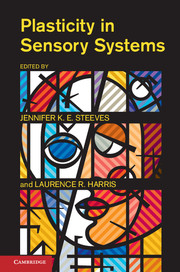Book contents
- Frontmatter
- Contents
- List of Contributors
- 1 Plasticity in Sensory Systems
- I VISUAL AND VISUOMOTOR PLASTICITY
- II PLASTICITY IN CHILDHOOD
- 5 Human Visual Plasticity: Lessons from Children Treated for Congenital Cataracts
- 6 Living with One Eye: Plasticity in Visual and Auditory Systems
- 7 Building the Brain in the Dark: Functional and Specific Crossmodal Reorganization in the Occipital Cortex of Blind Individuals
- 8 Crossmodal Plasticity in Early Blindness
- III PLASTICITY IN ADULTHOOD AND VISION REHABILITATION
- Author Index
- Subject Index
- References
7 - Building the Brain in the Dark: Functional and Specific Crossmodal Reorganization in the Occipital Cortex of Blind Individuals
from II - PLASTICITY IN CHILDHOOD
Published online by Cambridge University Press: 05 January 2013
- Frontmatter
- Contents
- List of Contributors
- 1 Plasticity in Sensory Systems
- I VISUAL AND VISUOMOTOR PLASTICITY
- II PLASTICITY IN CHILDHOOD
- 5 Human Visual Plasticity: Lessons from Children Treated for Congenital Cataracts
- 6 Living with One Eye: Plasticity in Visual and Auditory Systems
- 7 Building the Brain in the Dark: Functional and Specific Crossmodal Reorganization in the Occipital Cortex of Blind Individuals
- 8 Crossmodal Plasticity in Early Blindness
- III PLASTICITY IN ADULTHOOD AND VISION REHABILITATION
- Author Index
- Subject Index
- References
Summary
Introduction
The brain has long been considered as being hard wired in a predetermined manner shaped by evolution. This view has been challenged in the past decades by increasing evidence documenting the impressive capacity of the brain to be modulated through learning and experience, even well into adulthood. Pioneering studies of Hubel and Wiesel (1963; Hubel et al., 1977) on the development of ocular dominance columns have compellingly demonstrated that alterations in visual experience can influence the normal development of the visual cortex.
One of the most striking demonstrations of experience-dependent plasticity comes from studies in congenitally blind individuals (CB) showing dramatic cortical reorganizations as a consequence of visual deprivation. Experiments have documented that cortical sensory maps in the remaining senses of CB can expand with experience. For instance, finger representation in the somatosensory cortex is increased in blind individuals who are proficient Braille readers (Pascual-Leone et al., 1993; Sterr et al., 1999), and the tonotopic map in the auditory cortex is larger in visually deprived individuals (Elbert et al., 2002). Such cortical changes are thought to underlie enhanced reading abilities and auditory processing skills in the blind (Elbert et al., 2002; Sterr et al., 1998).
Aside from these examples of intramodal plasticity, massive crossmodal changes have been reported in the occipital cortex deprived of its natural visual inputs. In people born blind, occipital regions thatwould normally process visual stimuli are “hijacked” by the other senses as these regions become responsive to nonvisual input (Bavelier and Neville, 2002; Pascual-Leone et al., 2005).
- Type
- Chapter
- Information
- Plasticity in Sensory Systems , pp. 114 - 137Publisher: Cambridge University PressPrint publication year: 2012
References
- 5
- Cited by



